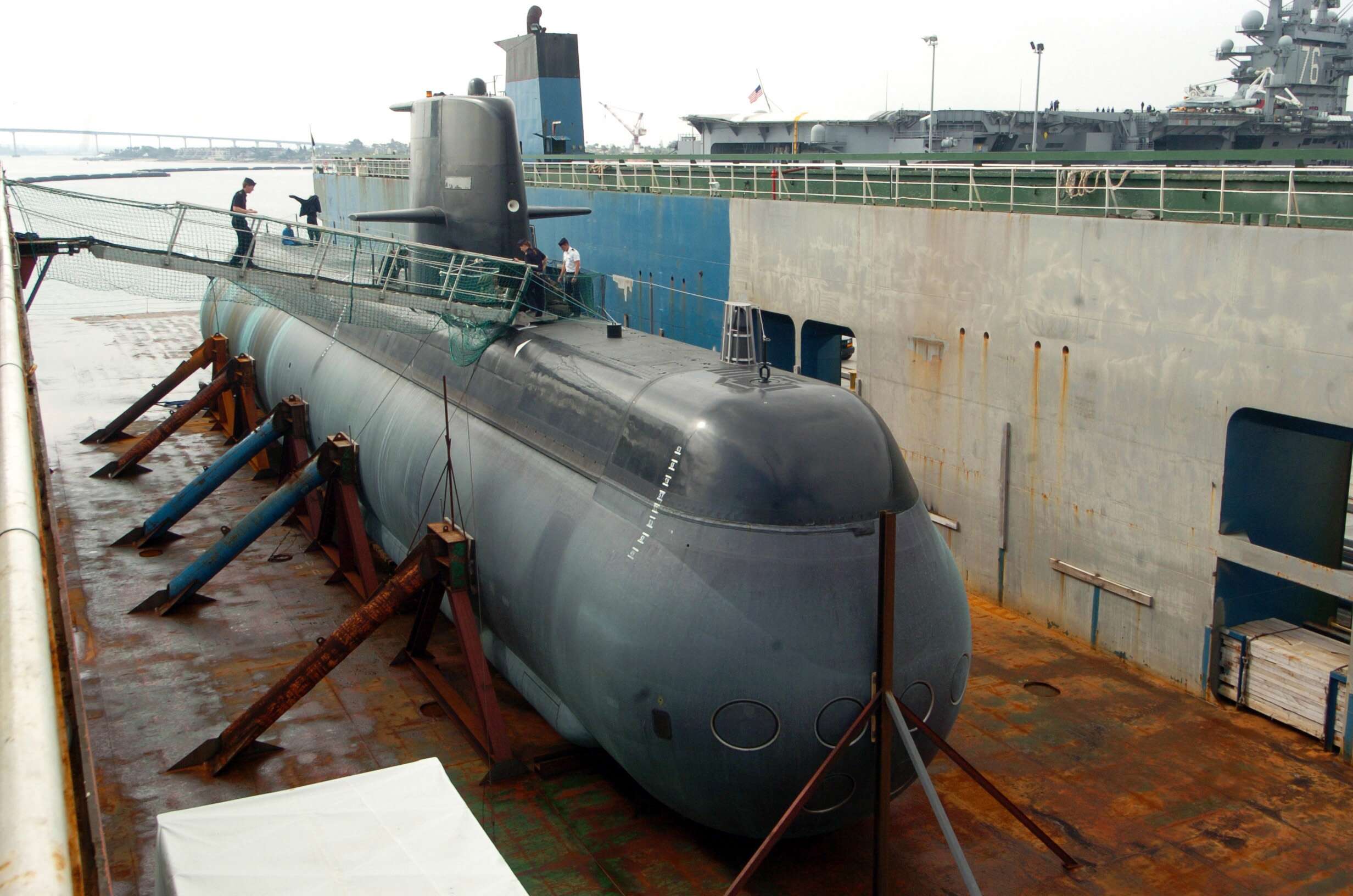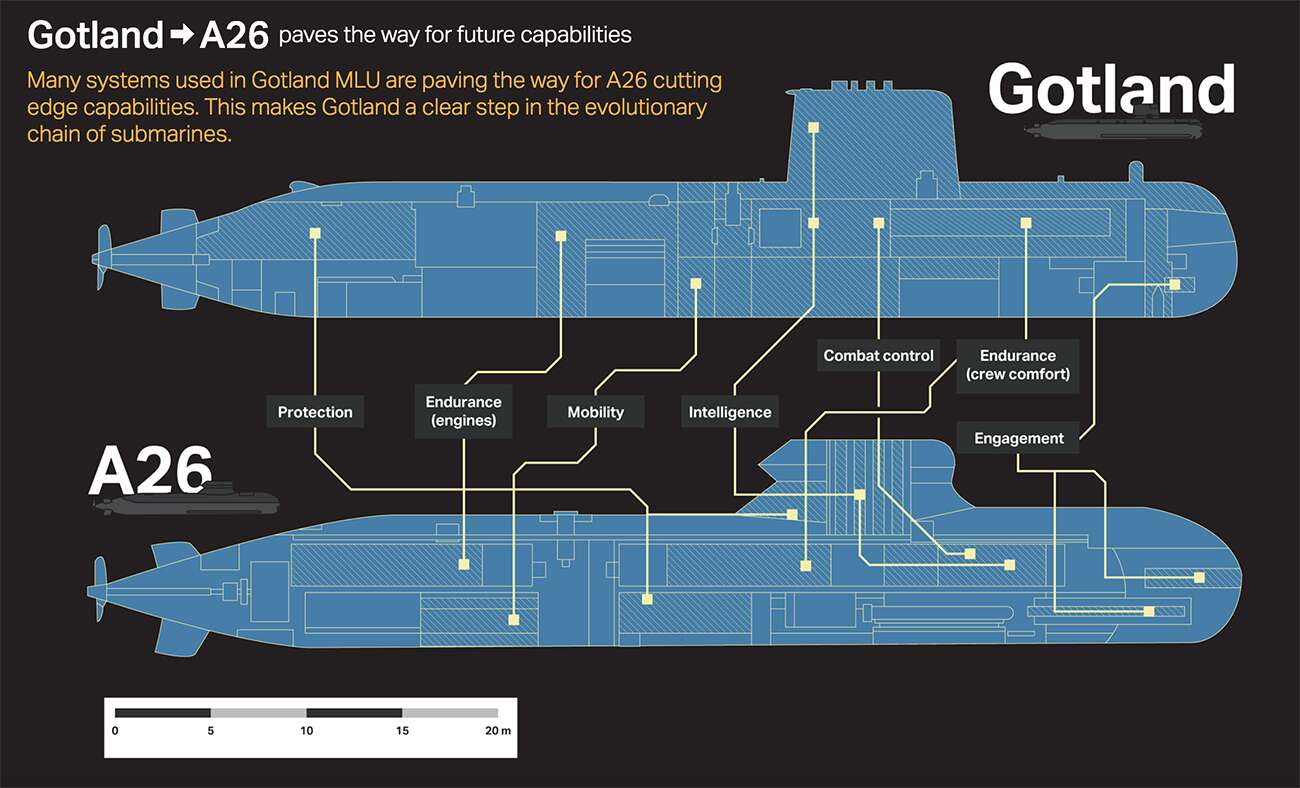HSwMS Gotland was built by SAAB-Kockums commissioned over two decades ago. The diesel-electric submarine outfitted with Stirling engine-based air-independent propulsion quickly changed the course of submarine warfare. Now, after an extensive mid-life refit, the famous subsurface stalker is about to begin sea trials and much more is riding on them than just validating a refit. Gotland was modernized in such a way that key technologies that are central to the upcoming A26 class, which aims to replace the Gotland class eventually, were woven into the project. So yeah, what was a proven, efficient, and very deadly submarine is now even more so.
You can read all about the Gotland and its innovations in this feature I penned back in 2014, but the submarine’s fame within defense circles came from its time working as a leased aggressor sub for the U.S. Navy in the mid-2000s. I previously wrote:
“By the mid 2000s, other countries were starting to field or develop AIP capable diesel-electric submarines, including Russia and especially China. Since the US Navy had retired its last diesel-electric (non-AIP) attack submarine in 1990, the USS Blueback (now a local resident here at Oregon’s Museum of Science & Industry) there was no indigenous force to practice hunting down diesel-electric subs, let alone ones with advanced AIP capabilities. Thus the U.S. Navy went to Sweden hat in hand in hopes of leasing one of their ninja-like Gotland Class boats and its crew for a year.
The Swedish sub would be playing the adversary to America’s massive constellation of anti-submarine surface combatants, helicopters, fixed wing aircraft, and especially nuclear submarines. The Swedes granted this request and the Gotland was shipped to San Diego aboard a mobile drydock.
By mid-summer of 2005, the Gotland arrived in San Diego and war games immediately commenced. Apparently, the Navy got more than they were bargaining for when it came to finding and engaging the stealthy little sub. The Gotland virtually “sunk” many US nuclear fast attack subs, destroyers, frigates, cruisers and even made it into the ‘red zone’ beyond the last ring of anti-submarine defenses within a carrier strike group.
Although it was rumored she got many simulated shots off on various U.S. super-carriers, one large-scale training exercise in particular with the then brand new USS Ronald Reagan ended with the little sub making multiple attack runs on the super-carrier, before slithering away without ever being detected.
One contact of mine within the anti-submarine community said that the Gotland was the single biggest eye opener of their career. The Swedish sub was “so silent it literally did not exist to our sensors.” Apparently, its crew knew exactly how to employ her strengths to devastating effects as that same contact described the sub as “a vastly demoralizing capability that changed the priorities within the surface and sub-surface warfare communities.”
Once the first year of the lease ran out, the Navy quickly arranged another year on the contract to sort through tactics to deal with this proliferating yet unassuming and deadly threat. It wasn’t until mid-2007 that the Gotland finally loaded up on its mobile drydock and headed back to its home on the Baltic Sea.
Fast forward the better part of a decade and AIP submarines, some more advanced than the Gotland Class, are prowling the seas and littorals around the globe. Seeing as these boats cost millions, instead of billions of dollars, they are potentially a fairly cheap way of shattering shipping in key global waterways, or even stalking coastlines for soft targets such as ships in port, not to mention having the potential of taking on some of the most capable anti-submarine forces in the world.”
Gotland arriving in San Diego in her transport dock in 2005.
Just in the four years since I published the piece on the Gotland and its time playing bad guy for America’s Navy, AIP technology has evolved dramatically. Today, diesel-electric submarines with AIP capability are approaching the size of nuclear-powered fast attack submarines, and are able to transit long distances to reach remote patrol stations with minimal support. Some of these boats are even executing nuclear second-strike deterrent patrols or will be in the near future.
Once largely experimental forms of AIP have also matured, including fuel cell-based systems. Maybe most promising of all are those based on lithium-ion batteries alone, as seen in the potentially revolutionary Japanese Soryu class.
Yet the Gotland’s Stirling engine-derived AIP technology remains highly efficient, cost-effective, and reliable. It’s been steadily improved upon over the decades and is now in its third major iteration. A new variation of the Stirling-engine system was part of the Gotland’s upgrade package, which necessitated the submarine being cut in half. According to SAAB, the refit included:
- Submarine is cut open in the mid-tank section, adding a new section including seawater cooling, fresh water cooling, water chiller units.
- Improved capabilities; Stirling AIP MkIII, Masts, Sensors, Communication, Special Ops.
- New rules and regulations: IMO, Security, Crew Comfort.
- End-of-life and obsolescence issues: Combat and Ship’s Management Systems.
- Experience-based improvement.
In particular, the ship’s combat systems, sonar, and mast were all replaced with the newest technology. Just moving from an optical periscope to a digital one is a huge upgrade for most submarines operating around the globe, so we aren’t talking about a freshening up here, but really a new submarine. And of course, this is the shadowy world of submarine warfare, in which the boat’s best capabilities would not be discussed in detail. This includes its ability to spy on potential adversaries, execute special operations insertions and extractions, and lay mines even in very shallow waters, something the Gotland class was designed specifically to do.
Not only will Gotland’s new capabilities be highly prized by the Swedish Navy, especially considering the rise of Russia’s naval capabilities and activities on the Baltic Sea, but they will pave the way for the upcoming A26 class.
The A26 program, which is more important now than ever, aims to produce the first two boats for just under $1B each, with follow-on units dropping substantially in price. Aside from some of the innovations that were installed on Gotland during its refit, the A26 will incorporate even quieter running technologies, a very stealthy sail, the ability to withstand greater shock loads, the ability to easily launch and recover large underwater unmanned vehicles, along with a host of other improvements.
https://youtube.com/watch?v=snvqXKSuc40%3Frel%3D0
https://youtube.com/watch?v=GXQdFjfwh9w%3Frel%3D0
Beyond the Swedish Navy’s needs, major aspects of the A26 design will be adopted by a Saab-Damen consortium in hopes of fulfilling the Netherland’s Walrus class submarine replacement program. Different configurations of the A26 design also include vertical launch tubes for a dozen cruise missiles and hull plugs for enhanced special operations capabilities.
A relaunching ceremony for Gotland is scheduled to occur on June 20th. Her sister ship Uppland will also be going through the modification process which takes about a year to complete. The entire program cost roughly $250M for both boats, which is a bargain considering the increase in capability. The third ship in the Gotland class, HSwMS Halland, remains active and it isn’t clear at this time if or when it will receive a similar mid-life treatment, although there was supposedly an option in the refit contract to proceed with the third boat at a fixed price.
Now, only if the U.S. Navy would jump onboard the A26 program, or a similar endeavor, and field a force of forward-deployed AIP capable boats. With production scale, the seagoing force could potentially buy three plus AIP equipped boats for the same price of a single Virginia class nuclear fast attack submarine. But that’s a whole other story that you can read all about here.
Contact the author: [email protected]
Source: Read Full Article


